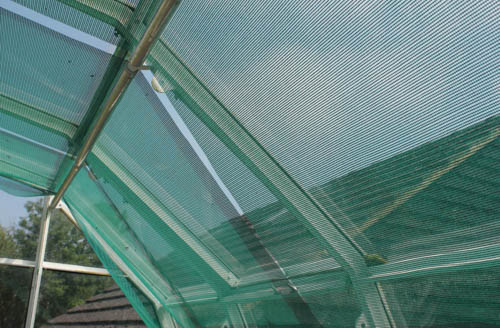
Now your greenhouse tomatoes are growing steadily, it is important to remove the side shoots of ‘cordon’ varieties to form a single productive stem. You don’t need scissors or secateurs, just snap them off with your finger and thumb. Make sure your tomatoes are well watered, too, particularly if they are in growing bags where the compost dries out rapidly. Aim to keep the compost moist. Erratic watering, when the compost fluctuates from wet to over dry, causes calcium deficiency showing as ‘blossom end rot’ later in the season, when the end of the fruit furthest away from the stem turns black. This can be avoided by keeping the compost constantly moist. Although they don’t look attractive, tomatoes suffering from ‘blossom end rot’ are still edible, just slice off the blackened end.
Fill your watering cans with water and allow them to stand in the greenhouse for at least 24 hours to warm up before use. Check your plants regularly as they may need watering two or three times during a hot sunny day. Regular watering allows your water butt to be replenished whenever rain arrives and keeps the contents fresh. Seedlings should be watered using rainwater, as the chlorine helps to control fungal diseases and if there is a shortage of rainwater, restrict its use to plants that need soft water like citrus fruits.
To prevent the glasshouse overheating, ventilate as temperatures rise during the day – small glasshouses heat up rapidly, so make sure that there are enough roof vents and louvres in the sides for ventilation – large glasshouses need a 1:5 ratio of metre square floor area to ventilation; smaller glasshouses need more. If the mornings are cool, start by opening the vents and finally the door, so that tender plants are not chilled by direct draughts as sunny weather is accompanied by cool easterly winds, especially during late spring. Scorching and high temperatures can be prevented by fitting blinds or painting the outside of the glass with shading. Shading stops temperatures at the leaf surface from rising too high; temperatures above 27C cause damage. Damp down the greenhouse two or three times a day during hot weather, particularly around cucumbers and melons. Tomatoes and aubergines need Mediterranean conditions, so grow them near the door where humidity is lower.
Feed Aubergines, tomatoes, peppers, chillies and other fruiting vegetables with high potash fertiliser once a week. Jekka Mc Vicar the ‘Queen of Herbs’ feeds her plants on Friday’s, as both begin with F, it’s a useful reminder. If you missed out on sowing fruiting crops, it is still not too late to buy plants from the garden centre, they ripen later but you will still have a harvest.
Keep your greenhouse tidy and check regularly for pests, like whitefly and red spider mite which can be controlled with biological controls or insecticides. Checking regularly is important; it is easier to control a smaller infestation than an epidemic.
Happy gardening. Matt.


